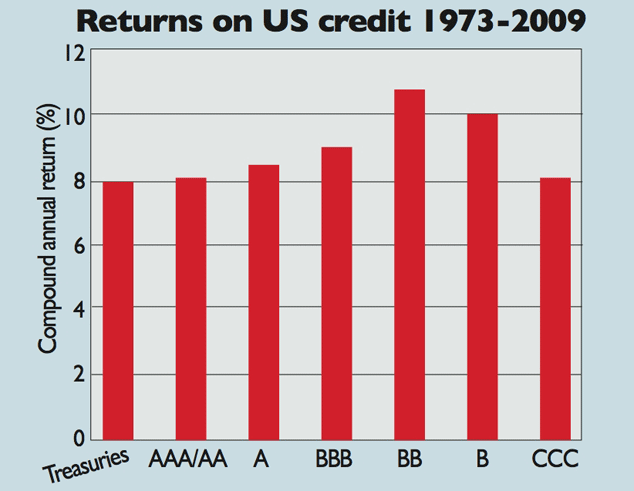
Junk bonds have been one of the biggest beneficiaries of record-low interest rates over the past five years. Also known as high-yield, speculative-grade and sub-investment-grade, these bonds carry a rating lower than ‘BBB’ from a credit-rating agency such as Moody’s or Standard & Poor’s. They offer higher yields than safer investment-grade bonds, but come with a significantly higher risk of default.
As result, they have traditionally been a specialist area of the bond market. But the low yields available on other income investments have encouraged many investors to venture into this area for the first time.
The question is whether these new investors fully understand the risks and returns they can expect from this asset class over time. Is there a danger that they are simply tempted by the promise of a higher yield today and are ignoring the potential losses? Let’s take a look at what history tells us about junk-bond returns – and what some investors may be overlooking.
A history of defaults
If you invest in a portfolio of bonds and hold them until they mature, your returns are determined by three factors: the interest rate you receive, the default rate among the bonds, and the recovery rate (how much you get back from those that default).
Obviously, you may make additional capital gains or losses by selling bonds before maturity. And many investors who have bought in to junk bonds may well be planning to sell them and rotate back in to safer investments once interest rates look set to rise.
However, since we are interested in underlying returns on the asset class, we can ignore these trading gains.
With most types of bond, we know what the interest rate is when we invest. However, the default rates and recovery rates we will experience are unknown and we can only be guided by history. Fortunately, credit-ratings agencies such as Moody’s have long-term data on these rates, which give us a good idea of what the pattern has been in the past.
One thing we can very clearly tell from this history is that default rates tend to be reasonably low for prolonged periods of time and then spike during times of distress.
For example, data from Moody’s shows that global junk-bond default rates were more than 15% per year at the peak of the Great Depression, around 8%-10% during the early 1970s, early 1990s and early 2000s, and almost 14% during the global financial crisis. These spikes are often fleeting, but they are the point when the worst damage to portfolios is done.
So, the fact that default rates are currently very low – global high-yield default rates were just 1.1% in 2013 – is not as reassuring as it may sound for investors. The issue is whether investors will see a period of higher defaults during the time they are invested and how much that will erode their long-term returns.
Obviously, losses when a bond defaults depend on the recovery rate and this varies greatly between bonds and over time. However, the average recovery rate has been around 40%, although recovery rates tend to be worse during periods with high default rates.
Surprising returns
So, what are the long-term returns on junk bonds once losses are taken into account? The chart below shows compound annual nominal returns on US bonds by credit rating, over the period from 1973 to 2009. You can see that it has a rather surprising pattern entirely at odds with what we would expect.
Theoretically, the riskiest financial assets should offer the highest returns, to compensate investors for taking on that risk. But this data suggests that the riskiest CCC-rated junk bonds have had lower returns than many safer bonds.
The best performers have been BB-rated – bonds rated just below investment grade. Why is this? There are probably two different factors involved.
First, some institutional investors are prohibited from holding bonds rated below investment grade and cannot buy BB bonds, even though they may be very similar in quality to those rated BBB and higher. As a result, BB bonds seem to have been structurally cheap historically and have delivered strong returns.
In particular, fallen angels – bonds that have been downgraded from investment grade to junk – ie, from BBB to BB – have probably been exceptionally good value immediately after their downfall, as some investors will have become forced sellers, pushing down prices.
Indeed, recent data suggests that fallen angels have strongly outperformed other junk bonds, returning 9.6% per year from 1997 to 2009, versus 5.7% for those originally issued with a sub-investment-grade rating.
The other factor is that investors may have overpaid for the riskiest bonds because of the high yields these offer, not fully appreciating the impact that an eventual spike in defaults will have.
While the average ten-year cumulative default rate for CCC bonds (in other words, the percentage of issuers defaulting within ten years) was more than 70% in the period from 1970-2009, the default rate in many years was in the low single digits.
When the worst of the losses tends to be clustered in a small period of each cycle, it’s easy for investors to assume they’ll be able to get out of the market in time.
A risky outlook
Obviously, we can’t be sure if these patterns will continue in future, but they certainly put the recent performance of junk bonds in context. There has been an exceptionally benign environment for borrowers in recent years: low rates and the hunt for yield have enabled even the worst-quality firms to issue new bonds and refinance maturing debt without much trouble.
When rates start to rise and investors no longer need to take so much risk to earn a decent return, that’s likely to change. We don’t know when the turning point will be, but when it happens, it seems doubtful whether current low yields will be enough to compensate for the likely spike in junk-bond defaults that we will see.